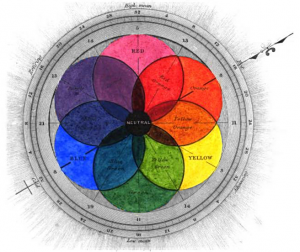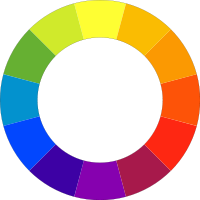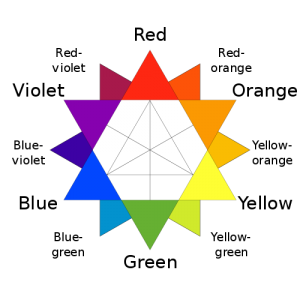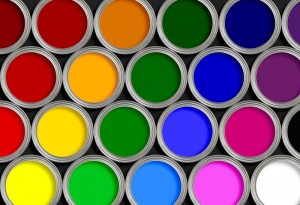As most of you know, color is light and energy. Color is visible because it reflects, bends, and refracts through all kinds of particles, molecules and objects. There are a variety of wavelengths that light can be categorized, producing different types of light. Visible wavelengths fall approximately in the 390 to 750 nanometre range and is known as the visible spectrum. Other wavelengths and frequencies are associated with non-visible light such as x-rays & ultraviolet rays. Most people are aware of the effects of non-visible light, so it makes sense that visible light would also affect us.
Color therapy and healing (also known as chromotherapy or light therapy) is a type of holistic healing that uses the visible spectrum of light and color to affect a person’s mood and physical or mental health. Each color falls into a specific frequency and vibration, which many believe contribute to specific properties that can be used to affect the energy and frequencies within our bodies.
While it is common knowledge that light enters through our eyes, it’s important to note that light can also enter through our skin. Given the unique frequencies and vibrations of various colors, people believe that certain colors entering the body can activate hormones causing chemical reactions within the body, then influencing emotion and enabling the body to heal.
Colors are known to have an effect on people with brain disorders or people with emotional troubles. For example, the color blue can have a calming effect which can then result in lower blood pressure, whereas the color red might have the opposite effect. Green is another color that may be used to relax people who are emotionally unbalanced. Yellow, on the other hand, may be used to help invigorate people who might be suffering from depression. (We’ll dive deeper into specific colors in a future article.)
It’s no mystery that the sun and its source of light (or lack thereof), can have a profound effect on us. Thousands of years ago, some countries began exploring color and its healing capabilities. Egypt, Greece and China are known for their forays into color healing and therapy. A few examples include:
There is evidence of people attempting to use color for healing and therapy from as far back as 2000 years. And it has gained in popularity throughout the years, with numerous books being written about it, including Johann Wolfgang Goethe who studied the physiological effects of color. As we mentioned though, many people are skeptical about using color and light for healing or therapy.
Stay tuned for upcoming articles over the next few weeks where we’ll introduce color meanings and symbolism, how we see color, and the various effects of specific colors.
Color Meanings & Symbolism
February 7th
Here are the topics covered in this article:
- The Meaning of Colors You Choose
- How Do We See Color?
- The Traditional Color Wheel
- What is Color Symbolism?
- Examples of Cultural & Religious Symbolism of Color
- Color Meanings & Symbolism of Primary and Secondary Colors
- Color Meanings/Symbolism Charts
- Books About Color Symbolism & Meaning
The Meaning of Colors You Choose
Carl Jung, a renowned psychiatrist and proponent of art therapy, encouraged his patients to use color because he felt this would help them express some of the deeper parts of their psyche. It is believed that the color choices you make reflect a deeper meaning about your personality traits. For example, introverts and extroverts are likely to choose different colors – blue and red respectively.
The colors you choose to wear might also say something about how you are feeling that day. Some days you may fee like wearing something lighter, something red, or something blue. These choices are often a reflection of how you are feeling at the moment. Additionally, wearing certain colors may cause you to react differently to certain situations.
How Do We See Color?
There are 2 main sources of light that create the colors we see: the sun and lightbulbs. As you know, the light from the sun allows us to see things during the day as well as during the night when the sun’s light reflects off the moon. There is a visible spectrum of colors that we can see in addition to the combination of all colors (white) and the absence of color (black).
Surfaces reflect and absorb light differently, which results in the colors we see through our eyes. For example, a tomato absorbs all light on the spectrum except the red rays of light. The red rays of light are reflected off the surface of the tomato which then reach our eyes for processing.
The colored light enters the eye through the pupil, goes through the lens, then reaches the back of the eye called the retina. On the retina there are a bunch of light sensors called rods and cones. These rods and cones send a signal to the brain about what the eye is seeing. The cones are capable of seeing three colors: red, green, and blue. These are known as primary colors (RGB Model) – more about this below.
The Traditional Color Wheel – primary, secondary, and tertiary colors
Here you can see a basic color wheel. It is based on 3 different types of colors: primary, secondary, and tertiary.
Primary Colors (Traditional RYB Model)
Primary colors consist of red, yellow, and blue. These 3 hues can not be mixed or formed by any combination of other colors. Additionally, all other colors are created by mixing these three colors.
Secondary Colors
Secondary colors consist of green, orange and purple (violet). Secondary colors are formed by mixing 2 primary colors.
Tertiary Colors
Tertiary colors consist of red-orange, yellow-orange, yellow-green, blue-green, blue-violet, and red-violet. Tertiary colors are formed by mixing primary and secondary colors, resulting in the two-word names.
If you’d like to know more about RGB and RYB models, CMYK, reflective and transmitted light, then there are lots of additional sources out there that cover more in-depth color theory. These are just some basic concepts for our series on color therapy, meanings, symbolism, et cetera.
Now that we’ve covered the basics of traditional color theory, let’s review color symbolism.
What is Color Symbolism?
Color symbolism is the use of color as a representation or meaning of something that is usually specific to a particular culture or society. Context, culture and time are certainly important factors to consider when thinking about color symbolism.
Examples of Cultural & Religious Symbolism of Color
Depending on the culture or society, colors may symbolize diffferent things for different people. Consider the United States as an example. What colors come to mind when you think about traffic lights and signs? What about the flag? How about Christmas or Halloween?
Even within the United States, there are cultures that hold certain colors sacred. For example, at least 3 Native American nations hold the same three colors sacred: black, white and yellow. Although, they each have 4 different colors they hold sacred in addition to black, white and yellow.
Navajo Nation –> turquoise
Apache Nation –> green
Iowa Nation –> red
Read more: http://www.arttherapyblog.com/online/color-meanings-symbolism/#ixzz1FsJW4chh
As was mentioned in
Color Therapy,
Color Meanings & Symbolism, and
Color Psychology we’ve created a variety of Color Symbolism & Meanings Charts. The first color symbolism chart combines 6 of the most common colors, what they symbolize, and common meanings. We’ve also created individual color meanings charts based on those six colors. Feel free to link to this page or the charts, just follow the directions below.
We also have
art & art therapy badges in a variety of sizes and colors. You can easily add these to your site or blog as well.
Here are the available color meaning charts:
- Main Color Meanings & Symbolism Chart (contains 6 colors)
- Color Symbolism Chart – RED
- Color Symbolism Chart – ORANGE
- Color Symbolism Chart – YELLOW
- Color Symbolism Chart – GREEN
- Color Symbolism Chart – BLUE
- Color Symbolism Chart – VIOLET/PURPLE
Main Color Meanings & Symbolism Chart – 6 Colors
This first chart contains the 6 main colors (red, orange, yellow, green, blue, violet) and their popular meanings/symbolism. You can view the
full color chart here, or by clicking on the image above.
Color Psychology: The Emotional Effects of Colors
February 27th
What is Color Psychology?
The psychology of color is based on the mental and emotional effects colors have on sighted people in all facets of life. There are some very subjective pieces to color psychology as well as some more accepted and proven elements. Keep in mind, that there will also be variations in interpretation, meaning, and perception between different cultures. Studying the effects of color and how we perceive it is frequent in psychology degree programs around the world.
Applying Color Psychology to Everday Life
Did you know your surroundings may be influencing your emotions and state of mind? Do you ever notice that certain places especially irritate you? Or that certain places are especially relaxing and calming? Well, there’s a good chance that the colors in those spaces are playing a part.
In art therapy, color is often associated with a person’s emotions. Color may also influence a person’s mental or physical state. For example, studies have shown that some people looking at the color red resulted in an increased heart rate, which then led to additional adrenaline being pumped into the blood stream. You can learn more about how
color therapy works and
how light and color might affect us.
There are also commonly noted psychological effects of color as it relates to two main categories: warm and cool. Warm colors – such as red, yellow and orange – can spark a variety of emotions ranging from comfort and warmth to hostility and anger. Cool colors – such as green, blue and purple – often spark feelings of calmness as well as sadness.
The concepts of color psychology can also be applied in everyday life. For example, maybe you’re planning on re-painting your walls or redecorating a house or room with a new color scheme. Well, you might want to consider some of these suggestions about colors and how they might affect your emotions and mood:
Psychological Effects of Cool Colors
Need to be creative? Want help getting those brain synapses firing? Try utilizing the color purple. Purple utilizes both red and blue to provide a nice balance between stimulation and serenity that is supposed to encourage creativity. Light purple is said to result in a peaceful surrounding, thus relieving tension. These could be great colors for a home or business office.
Are you looking for a peaceful and calming environment? You might consider using green and/or blue. These cool colors are typically considered restful. There is actually a bit of scientific logic applied to this – because the eye focuses the color green directly on the retina, it is said to be less strainful on your eye muscles.
The color blue is suggested for high-traffic rooms or rooms that you or other people will spend significant amounts of time. Another cool color, blue is typically a calming and serene color, said to decrease respiration and lower blood pressure. The bedroom is a great place to use these colors as they should help you relax.
Psychological Effects of Warm Colors
Want to create an environment of stimulation or whet people’s appetite? You might consider utilizing the colors yellow or orange. These colors are often associated with food and can cause your tummy to growl a little. Have you ever wondered why so many restaurants use these colors? Now you know why even after people watched the movie SuperSize Me, they said they were hungry.
You do want to be careful about using bright colors like orange and especially yellow. They reflect more light and excessively stimulate a person’s eyes which can lead to irritation. You also probably don’t want to paint your dining room or kitchen these colors if you’re a calorie-counter.
Pyschology of Color for Marketing & Advertising
Marketing and advertising are well-known for utilizing color psychology. The fact that some companies have heavily invested in this type of research and many others have followed through in its use shows they have at enough belief in the concepts of color psychology to implement them in their advertising.
Color is consistently used in an attempt to make people hungry, associate a positive or negative tone, encourage trust, feelings of calmness or energy, and countless other ways.
Most marketing and advertising executives will likely agree that there are benefits to understanding and utilizing the psychological effects of colors. Now let’s take a look at some of the more common traits of color psychology, by some common colors.
Common Psychological Effects of Colors
Keep in mind that certain shades or tones may result in very different meanings. Also, the context around the color, and even surrounding colors, can have an effect. Think of this as more of a beginning guide to color psychology.
Color Psychology: The Color White
- purity
- innocence
- cleanliness
- sense of space
- neutrality
- mourning (in some cultures/societies)
Color Psychology: The Color Black
- authority
- power
- strength
- evil
- intelligence
- thinning / slimming
- death or mourning
Color Psychology: The Color Gray
- neutral
- timeless
- practical
Color Psychology: The Color Red
- love
- romance
- gentle
- warmth
- comfort
- energy
- excitement
- intensity
- life
- blood
Color Psychology: The Color Orange
- happy
- energetic
- excitement
- enthusiasm
- warmth
- wealth prosperity
- sophistication
- change
- stimulation
Color Psychology: The Color Yellow
- happiness
- laughter
- cheery
- warmth
- optimism
- hunger
- intensity
- frustration
- anger
- attention-getting
Color Psychology: The Color Green
- natural
- cool
- growth
- money
- health
- envy
- tranquility
- harmony
- calmness
- fertility
Color Psychology: The Color Blue
- calmness
- serenity
- cold
- uncaring
- wisdom
- loyalty
- truth
- focused
- un-appetizing
Color Psychology: The Color Purple
- royalty
- wealth
- sophistication
- wisdom
- exotic
- spiritual
- prosperity
- respect
- mystery
Color Psychology: The Color Brown
- reliability
- stability
- friendship
- sadness
- warmth
- comfort
- security
- natural
- organic
- mourning (in some cultures/societies)
Color Psychology: The Color Pink
- romance
- love
- gentle
- calming
- agitation





No comments:
Post a Comment